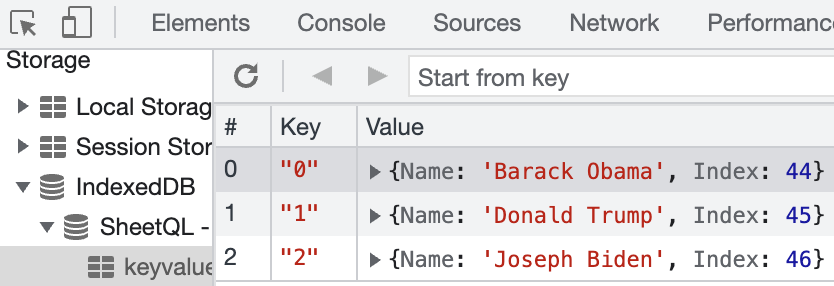IndexedDB API
IndexedDB is a very low-level API.
Browser vendors recommend using WebSQL or wrapper libraries in production applications.
The IndexedDB API provides an in-browser sandboxed local data store for JSON objects. Like the Local Storage API, IndexedDB is a popular choice for offline storage.
Wrapper Libraries
A number of popular wrapper libraries seek to simplify IndexedDB operations.
The wrapper libraries in this section have been used by SheetJS users in production sites.
localForage
This demo was last tested in the following environments:
| Browser | Date | localForage |
|---|---|---|
| Chromium 136 | 2025-05-21 | 1.10.0 |
| Safari 18.2 | 2025-05-21 | 1.10.0 |
| Konqueror 22 | 2025-04-23 | 1.10.0 |
localForage is a IndexedDB wrapper that presents an async Storage interface.
Arrays of objects can be stored using setItem using row index as key:
const aoo = XLSX.utils.sheet_to_json(ws);
for(var i = 0; i < aoo.length; ++i) await localForage.setItem(i, aoo[i]);
Recovering the array of objects involves an iteration over the storage:
const aoo = [];
await localforage.iterate((v, k) => { aoa[+k] = v; });
const ws = XLSX.utils.json_to_sheet(aoo);
Demo
This demo prepares a small IndexedDB database with some sample data.
After saving the exported file, the IndexedDB database can be inspected in the "IndexedDB" section of the "Application" Tab of Developer Tools:

function SheetJSLocalForage() { const data = [ { Name: "Barack Obama", Index: 44 }, { Name: "Donald Trump", Index: 45 }, { Name: "Joseph Biden", Index: 46 } ]; const xport = React.useCallback(async() => { /* force use of IndexedDB and connect to DB */ localforage.config({ driver: [ localforage.INDEXEDDB ], name: "SheetQL", size: 2097152 }); /* create sample data */ await localforage.clear(); for(var i = 0; i < data.length; ++i) await localforage.setItem(i, data[i]); /* pull data and generate aoa */ const aoo = []; await localforage.iterate((v, k) => { aoo[+k] = v; }); /* export */ const ws = XLSX.utils.json_to_sheet(aoo); const wb = XLSX.utils.book_new(); XLSX.utils.book_append_sheet(wb, ws, "Presidents"); XLSX.writeFile(wb, "SheetJSLocalForage.xlsx"); }); return ( <pre><button onClick={xport}><b>Do it!</b></button></pre> ); }
DexieJS
This demo was last tested in the following environments:
| Browser | Date | DexieJS |
|---|---|---|
| Chromium 136 | 2025-05-21 | 4.0.11 |
| Safari 18.2 | 2025-05-21 | 4.0.11 |
| Konqueror 22 | 2025-04-23 | 4.0.10 |
DexieJS is a minimalistic wrapper for IndexedDB. It provides a convenient interface for creating multiple logical tables, well-suited for workbooks.
Importing Data
When configuring tables, DexieJS needs a schema. The schema definition supports primary keys and other properties, but they are not required:
/* assuming `wb` is a workbook from XLSX.read */
var db = new Dexie("SheetJSDexie");
db.version(1).stores(Object.fromEntries(wb.SheetNames.map(n => ([n, "++"]))));
After the database is configured, bulkPut can insert arrays of objects:
/* loop over worksheet names */
for(let i = 0; i <= wb.SheetNames.length; ++i) {
/* get the worksheet for the specified index */
const wsname = wb.SheetNames[i];
const ws = wb.Sheets[wsname];
if(!ws) continue;
/* generate an array of objects */
const aoo = XLSX.utils.sheet_to_json(ws);
/* push to idb */
await db[wsname].bulkPut(aoo);
}
This demo inserts all data from a selected worksheet into a database, then fetches the data from the first worksheet in reverse.
After saving the exported file, the "IndexedDB" section of the "Application" Tab of Developer Tools will include a database named "SheetJSDexie".
/* The live editor requires this function wrapper */ function SheetJSDexieImport(props) { const [__html, setHTML] = React.useState("Select a spreadsheet"); return ( <> <input type="file" onChange={async(e) => { try { /* get data as an ArrayBuffer */ const file = e.target.files[0]; const data = await file.arrayBuffer(); /* parse worksheet */ const wb = XLSX.read(data); /* load into indexeddb */ await Dexie.delete("SheetJSDexie"); const db = new Dexie("SheetJSDexie"); const wsnames = wb.SheetNames.map(n => ([n, "++"])); db.version(1).stores(Object.fromEntries(wsnames)); /* loop over worksheet names */ for(let i = 0; i <= wb.SheetNames.length; ++i) { /* get the worksheet for the specified index */ const wsname = wb.SheetNames[i]; const ws = wb.Sheets[wsname]; if(!ws) continue; /* generate an array of objects */ const aoo = XLSX.utils.sheet_to_json(ws); /* push to idb */ await db[wsname].bulkPut(aoo); } /* fetch the first table in reverse order */ const rev = await db[wb.SheetNames[0]].reverse().toArray(); setHTML(rev.map(r => JSON.stringify(r)).join("\n")); } catch(e) { setHTML(e && e.message || e); }}}/> <pre dangerouslySetInnerHTML={{ __html }}/> </> ); }
Exporting Data
db.tables is a plain array of table objects. toArray fetches data:
/* create blank workbook */
const wb = XLSX.utils.book_new();
/* loop tables */
for(const table of db.tables) {
/* get data */
const aoo = await table.toArray();
/* create worksheet */
const ws = XLSX.utils.json_to_sheet(aoo);
/* add to workbook */
XLSX.utils.book_append_sheet(wb, ws, table.name);
}
This demo prepares a small database with some sample data.
function SheetJSDexieExport() { const data = [ { Name: "Barack Obama", Index: 44 }, { Name: "Donald Trump", Index: 45 }, { Name: "Joseph Biden", Index: 46 } ]; const xport = React.useCallback(async() => { /* prepare db */ await Dexie.delete("SheetJSDexie"); var db = new Dexie("SheetJSDexie"); db.version(1).stores({ Presidents: "++" }); db.Presidents.bulkPut(data); /* pull data and generate workbook */ const wb = XLSX.utils.book_new(); for(const table of db.tables) { const aoo = await table.toArray(); const ws = XLSX.utils.json_to_sheet(aoo); XLSX.utils.book_append_sheet(wb, ws, table.name); } XLSX.writeFile(wb, "SheetJSDexie.xlsx"); }); return ( <pre><button onClick={xport}><b>Do it!</b></button></pre> ); }